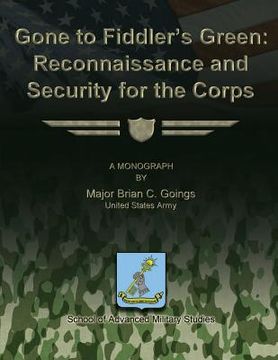Synopsis "Gone to Fiddler's Green: Reconnaissance and Security for the Corps"
The United States Army's transformation from the Army of Excellence design to the Modular design had profound changes for the corps organization. Armored cavalry regiments under the Army of Excellence design provided reconnaissance and security for corps. However, the pending transformation of the 3d Armored Cavalry Regiment to a Stryker brigade combat team fundamentally changed the way corps conduct reconnaissance and security. This change raised the issue of a corps ability to conduct reconnaissance and security without a dedicated land-based organization. This study addresses a corps requirement for reconnaissance and security through the criteria of doctrine, capability and organization. The study uses the criteria to describe how Army doctrine shapes a corps requirement for a reconnaissance and security organization, the capabilities such an organization requires, and the actual organizational structure of the reconnaissance and security force the Army designed. The case studies for analysis are the II Field Force, Vietnam and 11th Armored Cavalry Regiment in Operation TOAN THANG 43; VII Corps and 2d Armored Cavalry Regiment in Operation DESERT STORM; and V Corps in Operation IRAQI FREEDOM. The first two case studies represent different eras in the U.S. Army's history which saw corps-sized formations employ a dedicated reconnaissance and security organization. These case studies establish the Army's previous experience with armored cavalry regiments against different enemies and on different types of terrain. The last case study, Operation IRAQI FREEDOM, addresses a corps operating without a dedicated reconnaissance and security organization. The set of criteria to analyze the case studies are doctrine, capability, and organization. The main findings indicated the need for corps to have a dedicated reconnaissance and security organization. Although transformation in its final stages, the Army is still in a period of transition between the Army of Excellence and Modularity in terms of doctrine, organization, material, and leadership. The U.S. Army's experience in Cambodia in 1970 and Kuwait in 1991 demonstrated the importance a corps reconnaissance and security organization had during the execution of division and corps attacks. Regardless of the terrain or weather conditions, the armored cavalry regiments supporting division and corps-sized organizations, respectively, were able to locate the enemy and develop the situation through contact. Furthermore, the Army's experience has also shown the consequences of corps operating without a reconnaissance and security force. A corps without a dedicated reconnaissance and security organization lacked the ability to gather detailed information on the enemy and protect the force. During Operation IRAQI FREEDOM, technical intelligence, surveillance, and reconnaissance assets were unable to meet the 3d Infantry Division's information needs in the fluid combat environment. Modular corps will face similar difficulties in shaping the battlefield for its subordinate units. Without a dedicated reconnaissance and security organization at the corps-level, Army formations will require divisions and brigade combat teams to conduct the five-step attack sequence with limited means to gain and maintain contact. This means divisions or brigade combat teams will have to gain and maintain contact using the same forces that disrupt, fix, maneuver, and follow through. Therefore, a dedicated reconnaissance and security force is vital for corps operations.

